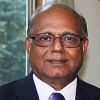Looking beyond one's own turf

"Leave no one behind" is the guiding spirit of the education agenda to be achieved by 2030 under the global Sustainable Development Goals adopted in 2015. Bangladesh is a party to the SDG 2030 pledge. How to think and act beyond the sectoral turf of ministries and agencies may be a major obstacle to fulfilling this vital pledge.
On April 6, a draft of a strategic framework for SDG4 (the overarching education goal among the17 SDG goals), prepared under the auspices of the two Ministries of Education and UNESCO Bangladesh Office, was shared with invited educationists. Senior ministry officials and the chief coordinator for SDGs at the Prime Minister's Office, Md Abul Kalam Azad, joined the discussion.
It was an occasion to take a broad view of the education situation with a longer time horizon, something that happens far too rarely. The study team attempted to look particularly at the state of pre-tertiary education against the global targets. As expected, improving learning outcomes of students, more effective governance and management, improving pedagogy and teachers' performance, and promoting market responsive vocational and technical skills were underscored.
Low public investment in education, around 2 percent of GDP, had to be raised substantially to at least 4 percent to achieve the goals, it was emphasised. Some of the officials, however, pointed to the need for better use of the resources. They also suggested that the investment in education was much higher if educational expenditures of all government agencies and household expenses were counted. This was a poor defence of the present situation because Bangladesh's low investment is actually in comparison to similar direct public education budgets of other countries, excluding the broader government and non-public expenditures.
What was not brought out in the draft strategy frame pointed to problems in the policy making process and limitations in the imagination of policymakers. I had raised this concern earlier, commenting on the Bangladesh Development Forum meeting, which was addressed by the Prime Minister in January, 2018 ('Questions not asked', The Daily Star, January 23, 2018).
In the discussion last year, there was no mention of some unique features of the Bangladesh education system that had proved to be barriers to necessary reforms to make the system "future-ready." These were bypassed again. There is a natural tendency in bureaucracy to guard its turf and not go "out-of-the-box."
For example, unlike any other country, school education from pre-primary to 12th grade in Bangladesh is looked after by two separate ministries. A casualty of the divided responsibility is the failure to extend universal and compulsory education to grade eight, envisaged nine years ago in the Education Policy 2010.
Looking at it as a matter of transferring grades 6-8 from one ministry to another, rather than as a matter of finding teaching-learning solutions, has put it in a limbo.
To his credit, Mr Sohrab Hossain, Senior Secretary of Ministry of Education observed that dividing school education under two ministerial jurisdictions was not helpful, though he thought it was a difficult issue to raise. "There could be ten divisions under the ministry, but it should be under one leadership," he said. It is, however, not clear why it should be difficult even to discuss, except perhaps because of the urge to protect one's turf.
The education system of about 40 million students and some 200,000 institutions in Bangladesh is uniquely managed, rather mismanaged, by an extremely centralised structure. An upazila has an average of 100,000 school students and 300-400 educational institutions of various kinds. Even a rhetorical mention of decentralised management with accountability is missing in the draft.
Ironically, teachers and their institutions all want to be fully taken over by the central government. The system and mindset of a centralised management have encouraged this counterproductive culture. This may benefit teachers, turning them into government personnel, but appears to do little to improve teaching and learning, with accountability to parents and the community.
Coming back to teachers, teaching is the last occupational choice of university graduates, after they fail to get into any other public and private sector job. Suggestions have been made at different times for adopting a "concurrent" teacher preparation model of recruiting young people after secondary education and taking them through a four-year undergraduate general education along with pedagogy as an area of instruction.
This is the practice in East Asia and most developed countries. To attract the "best and the brightest" to teaching, Bangladesh also can create a national teaching service corps who could be placed and paid for by the government in both government and government-assisted institutions.
The strategy draft tip-toed around the harsh fact that no specific universalisation plan exists yet for education beyond grade 5 primary education, though the global target is for universal secondary education by 2030. Similarly, there is no agreed strategy or comprehensive plan for other vital SDG4 targets—vocational/technical skill development, adult and lifelong learning, and early childhood education.
The strategy draft recommends an inter-ministerial steering committee for implementing the strategy. It fought shy of a permanent statutory National Education Commission, anticipated in Education Policy 2010, as a mechanism for guiding, exercising oversight and assessing progress and impact of education reforms. The inter-ministerial committee would be necessary, but not a substitute for a national commission.
The SDG Coordinator, Mr Azad, noted that the draft strategy framework team started from the education targets for 2030 and then considered the actors and the actions, rather than carving out first each ministry's tasks in SDG4, the usual bureaucratic approach. He thought turning it around to determine the target-related tasks and decide how the ministries and agencies could put in their effort could be a more effective approach. Mr Azad said such an approach may be considered also for other SDG targets. It is hoped that he would take the lead in this effort.
The need for a transversal rather than a sectoral and segmented approach is being recognised at the international level. The international EFA Steering Committee under UNESCO auspices plans to recommend this approach to the High Level Policy Forum (HPLF) for SDG4 to be held at the UN in July.
The evocative message to HPLF is to think beyond averages (looking at the diverse and disaggregated situations), beyond access (ensuring outcomes), beyond basics (not just cognitive knowledge and skills), beyond school (lifelong learning and the community surroundings), beyond education (actual learning), and beyond country (global citizenship and human solidarity). These are good concepts to go by in constructing the strategy and plan for Education 2030.
Dr Manzoor Ahmed is professor emeritus at BRAC University.

 For all latest news, follow The Daily Star's Google News channel.
For all latest news, follow The Daily Star's Google News channel. 



Comments